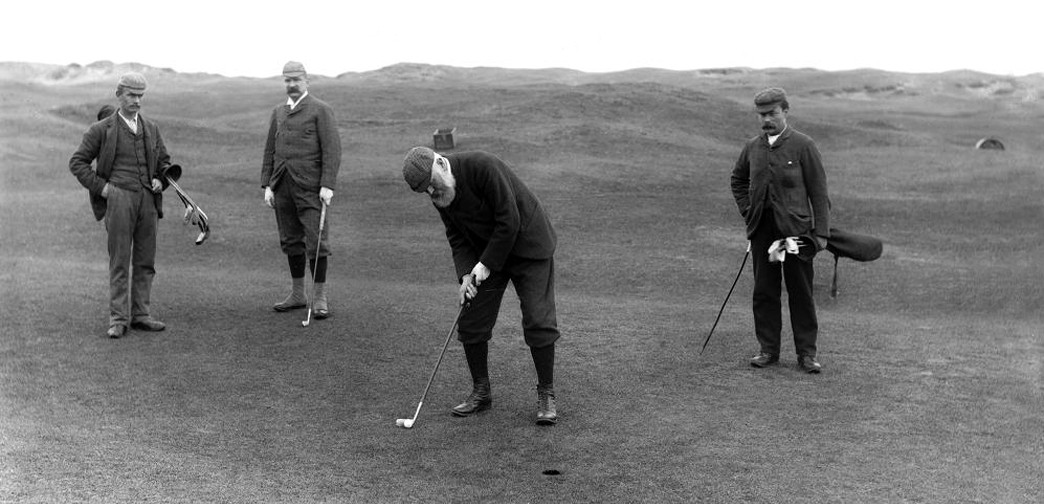Golf
Welcome and thanks for visiting...

The Evolution of Golf: From Old Tom Morris to Tiger Woods

The Days of Old Tom Morris
From the days of Old Tom Morris, the grandfather of golf, to the modern era of Tiger Woods, the game of Golf has come a long way- When the first instruction book, The Golfer’s Manual by “A Keen Hand” or H.B. Fannie was released; When the game was played with a ‘featherie’ and Hickory golf clubs, to the ‘guttie golf ball’ and then the rubber cored Haskell ball. Old Tom Morris played ‘sillybodkins’ with his friends at the age of ten, utilizing corks as balls and a homemade club. He started as an apprentice to Allan Robertson, who made featherie balls and Hickory golf clubs, and later went on to win the Open Championship and the title of “Champion Golfer of the Year”. He continues to be the oldest Open Champion, being 46 years old when he won his last Open Championship. In 1865 he returned to St. Andrews to become the greenskeeper pioneering many modern approaches to greenskeeping. He introduced the concept of top-dressing greens with sand helping turf growth and managing hazards, such as bunkers, on the golf course which was earlier allowed to grow wildly. He also introduced the first teeing area separate from the green, pioneered the strategic golf course design, introduced the modern concept of placing hazards in a manner where they could be planned around, and introduced yardage markers.
Golf in Late 19th Century
In 1881, moulds were invented to dimple the gutta-percha ball so that it worked much better in the air. As the game of golf evolved, the Ladies' Golf Club at St. Andrews- the first golf club for women was founded in 1867. In 1890 the concept of "Ground Score" was conceived by Hugh Rotherham, and suggested to Dr. Thomas Browne, honorary secretary of the Great Yarmouth Club. This meant comparing a handicap playing a match against the number of shots played by a hypothetical perfect golfer at every hole. It was introduced on a match-play basis at the club and during one of the matches a golfer playing incredibly well was hailed as a Bogey Man by Dr Browne and the ground score became known as a 'bogey’.
In 1892, for a match between Douglas Rollard and Jack White at Cambridge, Gate money was charged for the first time, which later went on to become the source of legitimate prize money. Six years later, the term "birdie" was coined at Atlantic C.C. from "a bird of a hole", and the first rubber-cored ball was designed and patented by Coburn Haskell. At the turn of the century, Golf was placed on the Olympic calendar for the 2nd Games at Paris. In 1901, Walter Travis won his second U.S. Amateur and became the first player to win a major title with the Haskell ball. Sunningdale, the first course with grass grown completely from seed and built amidst a cleared forest, opened for play. In the following year, the first grooved-faced irons were invented. A couple of years later, Walter Travis became the first American to win the British Amateur using the center-shafted Schenectady putter.
Golf in Early 20th Century
In 1905, William Taylor patented the first dimple pattern for golf balls in England. In the same year, The Complete Golfer by Harry Vardon, promoting and demonstrating the Vardon or overlapping grip, was published. The year 1908 saw Gordon Robertson, become the first female professional at Princes Ladies GC, and the publication of books titled The Mystery of Golf by Arnold Haultain, and The American Golfer by Walter Travis. Unfortunately, a dispute over the format of the competition led to the cancellation of the golf tournament at the 1908 Summer Olympics.
In 1913, Francis Ouimet, a 20-year-old amateur, stoked America’s interest in golf by winning the U.S. Open at The Country Club, Boston, where he used to caddie, defeating British legends Harry Vardon and Ted Ray in an 18-hole playoff. In 1927, the inaugural Ryder Cup Matches were played between the United States and British teams. The creeping bentgrass was developed for putting greens by the U.S. Agriculture Department. Bobby Jones became the first Grand Slam winner in 1930. The following year, Billy Burke became the first golfer to win a major championship using steel-shafted golf clubs. The year 1934, saw the official U.S. PGA Tour being created, built around events like the major championships, Western Open, and Los Angeles Opens which pre-dated it. Paul Runyan became the first official Money List leader.
When steel shafts came in the mid-1920s, players began carrying loads of clubs. But the 14-Club Rule, enacted in 1938, limited the number of clubs allowed to be used in a round to 14. In 1940 the Second World War broke out and the British Open and Amateur were discontinued for the duration of the war and Golf courses across the U K were converted to airfields or given over to anti-invasion and anti-air defenses. In 1942, the U.S. Open was discontinued, too. A worldwide rubber shortage, which is a vital military supply, created a shortage and drastic price increase of golf balls.
Golf in Late 20th Century
In 1968, Professional Golfers Association (PGA) tour was formed while in 1971 the game made it to the Moon when astronaut Alan Shepard hit a golf ball on the moon with a 6-iron he smuggled onto the Apollo 14 capsule. In 1978 Gary Adams, started making drivers with stainless-steel heads and launched TaylorMade Golf, the next year. Ron Streck became the first pro to win a tournament- the Michelob-Houston Open, using a metal wood in 1981, while the Big Bertha driver was introduced in 1991 by Callaway. Today, metal accounts for more than 99 percent of wood sales.
The year 1995 saw the course architecture take a 180-degree turn to the natural with the opening of Sand Hills, designed by Bill Coore and Ben Crenshaw, in the true middle of nowhere—Mullen, Neb. Amid dunes, the architects found more than 130 holes that had to be pared down to 18.
Golf in 21st Century- The Era of Tiger Woods
The following year Tiger Woods turned pro taking the game by storm, completing the “Tiger Slam,” in 2000–01 holding all four major championship titles at the same time.
But the year 2007 marked a watershed in the game with Mark Broadie, a Columbia Business School professor, inventing the Strokes Gained system. The PGA Tour started compiling official Strokes Gained statistics in 2011, thus Strokes Gained: Putting was introduced in 2011. In 2014, Broadie published his book, Every Shot Counts, which explains Strokes Gained statistics and the many insights he uncovered by analyzing player performance. Technology such as Pinpoint golf GPS app have enabled statistic tracking aggregating precise areas needing improvement.
In 2016, golf returned to the world stage in the Rio Olympics. Male and female players from 41 countries, including Israel, Russia, Bangladesh, and Morocco, represented their nations.
Conclusion
When the Ryder Cup started in 1927 it was played between the teams from the U.S. and Great Britain, only. But from 1979 onwards, players from Spain, Germany, Sweden, Italy, Denmark, France, and Belgium joined the British team to make it ‘Continental Europe’. Golf has truly become a global game now because, as of 2021 there were golf courses in 206 of 251 countries and dependent territories, according to the National Golf Foundation.
Travis Hartman is a Sports Analyst at Pinpoint Golf, where he writes about training sessions or games and creates video highlights to provide to managers and players for review.









